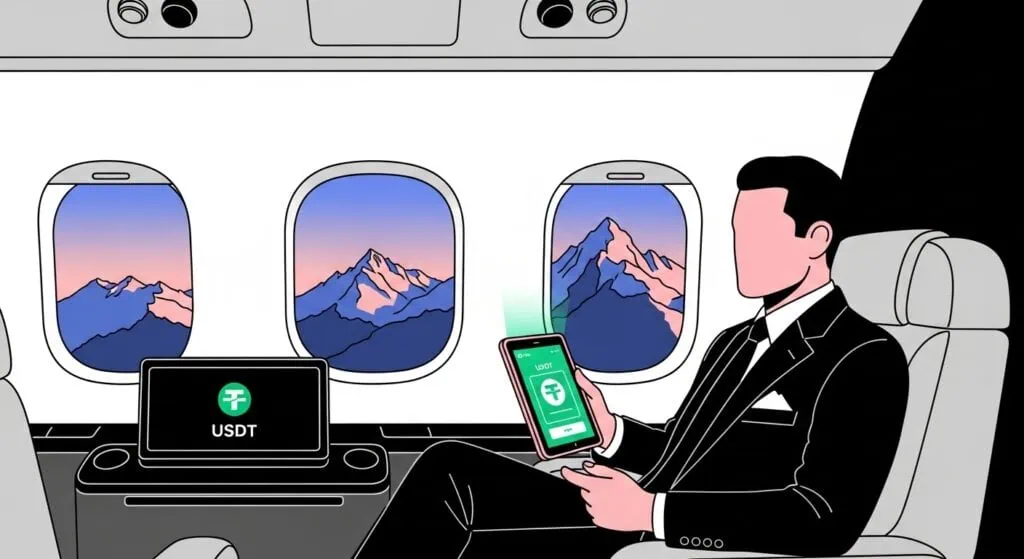USDT payment methods have revolutionized private aviation transactions, offering the stability of traditional currency with the speed and efficiency of blockchain technology. As the world’s largest stablecoin by market capitalization, Tether (USDT) provides aviation clients with predictable pricing, instant settlements, and reduced transaction costs compared to conventional banking systems.
Understanding USDT Payment Methods in Aviation
What Makes USDT Ideal for Private Aviation
USDT payment methods eliminate the volatility concerns associated with other cryptocurrencies while maintaining all blockchain advantages crucial for high-value aviation transactions.

Core USDT Payment Advantages:
- Price Stability: USD-pegged value prevents cryptocurrency volatility
- Transaction Speed: 2-15 minute settlement vs 2-3 days for wire transfers
- Lower Fees: 0.1-1% transaction costs vs 2-4% traditional methods
- 24/7 Availability: No banking hours or weekend delays
- Global Accessibility: Cross-border payments without currency conversion
- Transparency: Blockchain verification and audit trails
USDT Networks and Transaction Types
Modern USDT payment methods operate across multiple blockchain networks, each offering different advantages for aviation transactions.
Primary USDT Networks:
- Ethereum (ERC-20): Most established, highest liquidity
- Tron (TRC-20): Lower fees, faster confirmation times
- Binance Smart Chain (BEP-20): Reduced gas costs
- Polygon (MATIC): Ultra-low fees for smaller transactions
- Arbitrum: Layer 2 solution with instant finality
USDT Payment Processing for Private Jets
Step-by-Step Transaction Process
Implementing USDT payment methods for private aviation requires understanding the complete transaction workflow from quote to settlement.

Phase 1: Quote and Verification
Initial Setup (5-10 minutes):
- Aircraft Selection: Choose jet based on route and passenger requirements
- USDT Quote Generation: Operator provides real-time Tether pricing
- Wallet Verification: Customer submits receiving wallet address
- KYC Compliance: Enhanced due diligence for high-value transactions
- Rate Lock: 30-60 minute price guarantee due to minimal volatility
Phase 2: Payment Execution
Transaction Process (10-30 minutes):
- Smart Contract Deployment: Automated escrow for booking security
- USDT Transfer Initiation: Customer sends Tether to operator wallet
- Network Confirmation: Blockchain verification (2-6 confirmations)
- Payment Validation: Operator confirms USDT receipt
- Booking Confirmation: Charter activated upon settlement
Phase 3: Service Delivery
Completion Protocol (Real-time):
- Flight Manifest Update: Passenger details added to aircraft systems
- FBO Coordination: Ground services and fuel arrangements
- Crew Assignment: Pilots and cabin staff scheduling
- Weather Monitoring: Route optimization and backup planning
- Customer Communication: Real-time updates and service coordination
USDT Transaction Fees and Cost Analysis
Comprehensive Fee Breakdown
Understanding USDT payment methods requires analyzing all associated costs compared to traditional aviation payment systems.

Network Fee Comparison (Per Transaction)
| Network | Typical Fee | Confirmation Time | Best For |
|---|---|---|---|
| Ethereum (ERC-20) | $15-50 | 2-5 minutes | Large transactions >$100K |
| Tron (TRC-20) | $1-3 | 1-3 minutes | Medium transactions $10K-100K |
| BSC (BEP-20) | $0.50-2 | 1-3 minutes | Frequent smaller payments |
| Polygon | $0.01-0.50 | 10-30 seconds | Multiple small transactions |
Total Cost Analysis: $75,000 Private Jet Charter
USDT Payment Methods vs Traditional:
| Payment Method | Base Cost | Transaction Fee | FX Spread | Processing Fee | Total Cost | Settlement Time |
|---|---|---|---|---|---|---|
| USDT (Tron) | $75,000 | $2 | $0 | $0 | $75,002 | 3 minutes |
| USDT (Ethereum) | $75,000 | $25 | $0 | $0 | $75,025 | 5 minutes |
| Wire Transfer | $75,000 | $150 | $750 | $0 | $75,900 | 2-3 days |
| Credit Card | $75,000 | $2,250 | $0 | $0 | $77,250 | Instant auth |
Potential Savings: $898-2,248 per charter through USDT payment methods
Security Protocols for USDT Aviation Payments
Multi-Layer Security Framework
USDT payment methods for private aviation implement institutional-grade security measures to protect high-value transactions.

Operator Security Measures
Wallet Infrastructure:
- Multi-Signature Requirements: 3-of-5 signature authorization for large transactions
- Cold Storage Integration: 80% of funds stored offline
- Hot Wallet Limits: Maximum $500K exposure for operational liquidity
- Real-Time Monitoring: AI-powered fraud detection systems
- Insurance Coverage: Lloyd’s of London cryptocurrency theft protection
Customer Protection Protocols
Transaction Security:
- Address Verification: Multiple confirmation steps before payment
- Two-Factor Authentication: Enhanced security for wallet access
- Time-Limited Transactions: Automatic expiration for security
- Escrow Services: Smart contract protection until service delivery
- Dispute Resolution: Blockchain-based arbitration systems
Regulatory Compliance Framework
AML/KYC Requirements:
- Enhanced Due Diligence: Source of funds verification for $50K+ transactions
- FATF Travel Rule: Cross-border transaction reporting compliance
- Real-Time Screening: Sanctions and PEP list verification
- Transaction Monitoring: Suspicious activity detection and reporting
- Record Keeping: 7-year blockchain transaction history maintenance
Regional USDT Payment Acceptance
Geographic Availability and Regulations
USDT payment methods availability varies significantly across aviation markets, with regulatory frameworks influencing operator adoption.

High-Adoption Regions
Crypto-Friendly Jurisdictions:
- Switzerland: Full regulatory clarity, 95% operator acceptance
- Singapore: Comprehensive framework, 90% market adoption
- UAE: Progressive policies, 85% operator integration
- Bahamas: Favorable regulations, 80% charter acceptance
- Cayman Islands: Offshore financial hub, 90% adoption rate
Emerging Markets
Growing Acceptance:
- United States: Increasing adoption, 60% operator acceptance
- United Kingdom: Regulatory development, 55% market penetration
- Germany: Conservative approach, 45% operator adoption
- France: Evolving framework, 40% acceptance rate
- Canada: Provincial variations, 50% overall adoption
Regulatory Considerations by Region
Compliance Requirements:
- EU Markets: MiCA regulation compliance, VAT implications
- US Operations: FinCEN reporting, state-by-state variations
- Asian Markets: Local licensing requirements, central bank policies
- Offshore Jurisdictions: Streamlined processes, enhanced privacy
- Latin America: Emerging frameworks, variable enforcement
Integration with Aviation Booking Systems
Technology Infrastructure Requirements
Modern USDT payment methods require sophisticated integration with existing aviation booking and management systems.
Core Technology Stack:
- Blockchain Nodes: Direct network connectivity for real-time verification
- API Integration: Seamless connection with booking platforms
- Wallet Management: Enterprise-grade custody solutions
- Price Feed Systems: Real-time USDT/USD conversion rates
- Compliance Monitoring: Automated AML/KYC verification systems
Booking Platform Integration
Popular Aviation Software:
- ForeFlight: USDT payment plugin for flight planning
- Avinode: Integrated cryptocurrency payment processing
- PrivateFly: Direct USDT acceptance through smart contracts
- Victor: Blockchain payment gateway integration
- JetSmarter: Proprietary USDT processing system
Advanced USDT Payment Features
Smart Contract Automation
USDT payment methods increasingly leverage smart contracts for automated aviation transaction management.

Automated Features:
- Conditional Payments: Funds released upon service delivery confirmation
- Weather Protection: Automatic refunds for operator cancellations
- Multi-Party Splits: Automatic distribution to crew, FBO, and fuel suppliers
- Loyalty Programs: Token-based rewards for frequent flyers
- Insurance Integration: Parametric coverage triggered by smart contracts
Yield Optimization Strategies
Treasury Management:
- Staking Rewards: Earn yield on USDT reserves while maintaining liquidity
- Liquidity Mining: Participate in DeFi protocols for additional returns
- Lending Markets: Generate passive income on operational float
- Yield Farming: Strategic deployment across multiple protocols
- Risk Management: Diversified approach with capital preservation focus
Future Developments in USDT Payments
Emerging Technologies and Trends
The evolution of USDT payment methods continues accelerating with new blockchain technologies and regulatory developments.
Technological Advances:
- Layer 2 Solutions: Lightning Network integration for instant settlements
- Cross-Chain Bridges: Seamless movement between blockchain networks
- Central Bank Digital Currencies: Integration with government-issued digital currencies
- Quantum Resistance: Post-quantum cryptography implementation
- AI Integration: Machine learning for fraud detection and optimization
Regulatory Evolution
Expected Developments:
- Global Standards: International coordination on stablecoin regulations
- Tax Clarity: Simplified reporting requirements for businesses
- Insurance Frameworks: Standardized coverage for cryptocurrency transactions
- Compliance Automation: Regulatory technology (RegTech) integration
- Consumer Protection: Enhanced safeguards for high-value transactions

Frequently Asked Questions
How secure are USDT payment methods for private aviation transactions? USDT payment methods employ institutional-grade security including multi-signature wallets, cold storage protection, and real-time fraud monitoring. Major operators maintain insurance coverage through Lloyd’s of London and implement smart contract escrow systems to protect customer funds until service delivery confirmation.
What are the actual costs of using USDT payment methods vs traditional banking? USDT payment methods typically cost $1-50 per transaction regardless of amount, compared to 2-4% fees for credit cards and wire transfer spreads of 1-2%. For a $75,000 charter, USDT can save $898-2,248 in total fees while settling in minutes instead of days.
Which USDT network should I use for private jet payments? For transactions over $100,000, Ethereum (ERC-20) offers maximum security and liquidity despite higher fees ($15-50). For smaller amounts, Tron (TRC-20) provides optimal balance of speed and cost ($1-3 fees). Always verify which networks your operator accepts before initiating payment.
Do I need special software or wallets for USDT aviation payments? Most operators accept USDT from standard wallets like MetaMask, Trust Wallet, or hardware wallets like Ledger. Some aviation companies provide proprietary payment interfaces. Multi-signature business wallets are recommended for transactions exceeding $250,000 for enhanced security.
How do USDT payment methods handle refunds and cancellations? Smart contract-based USDT systems enable automatic refunds within 24-48 hours for operator cancellations. Weather delays typically trigger partial refunds based on pre-programmed conditions. Manual refunds for customer cancellations process within 2-5 business days depending on operator policies.
What tax implications exist for using USDT payment methods in aviation? USDT transactions may trigger reporting requirements depending on jurisdiction and transaction size. In the US, payments over $10,000 require FinCEN reporting. Consult tax professionals regarding potential capital gains implications if USDT has appreciated since acquisition. Business use may qualify for expense deductions.
Implementing USDT Payment Methods
For comprehensive cryptocurrency payment integration in private aviation, explore our crypto private jet booking guide covering Bitcoin and Ethereum alternatives alongside USDT options.
Additional aviation payment solutions include traditional private jet services and helicopter charter options with emerging cryptocurrency acceptance.
External Resources
For current USDT regulations and compliance requirements, consult the Financial Action Task Force (FATF) guidelines and Securities and Exchange Commission (SEC) digital asset frameworks for institutional compliance.
This guide to USDT payment methods represents current market practices and regulatory frameworks as of 2025. Cryptocurrency regulations and technology implementations continue evolving rapidly. Always verify current compliance requirements and operator capabilities before processing transactions.




















